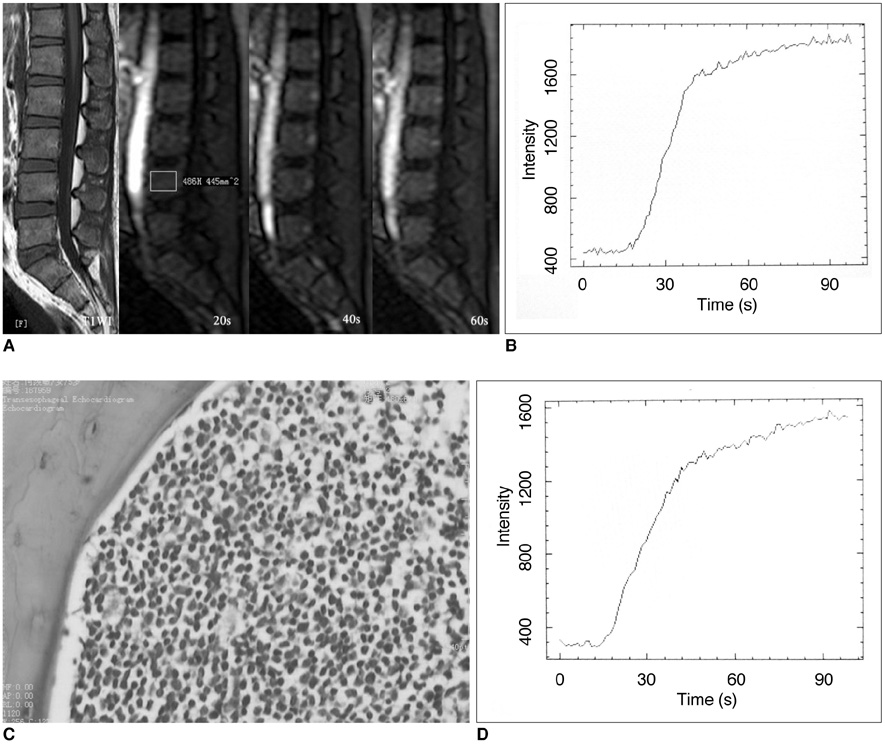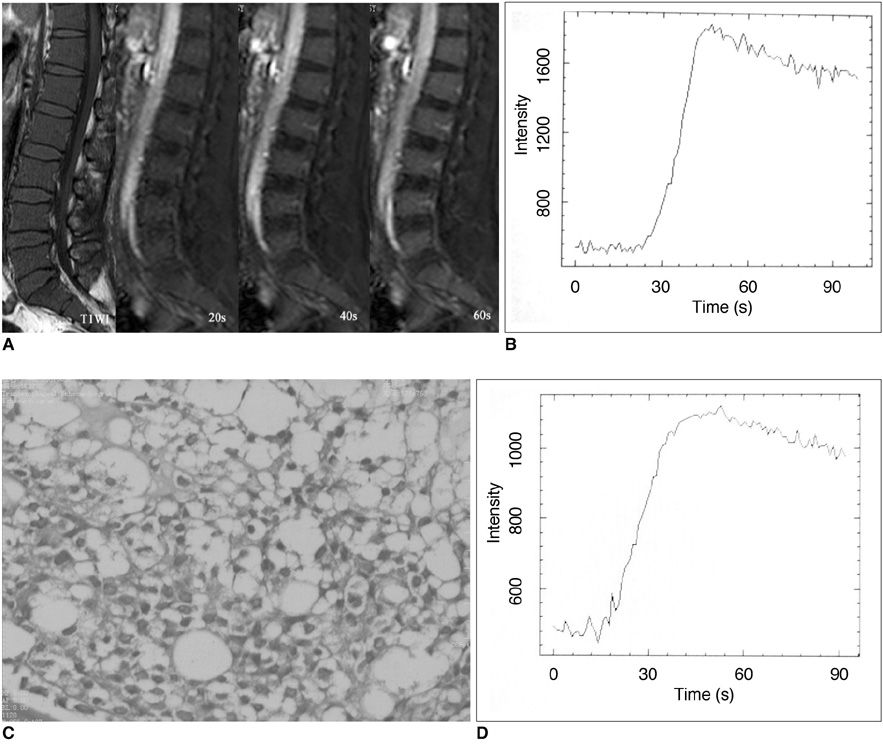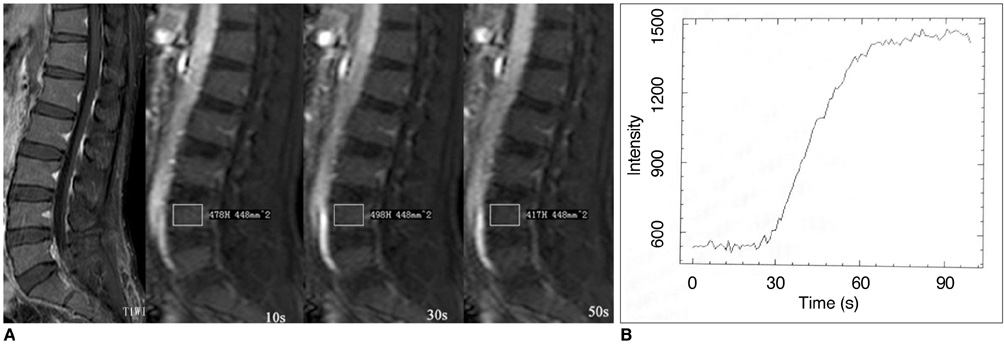Korean J Radiol.
2010 Apr;11(2):187-194. 10.3348/kjr.2010.11.2.187.
Dynamic Contrast Enhanced Magnetic Resonance Imaging of Diffuse Spinal Bone Marrow Infiltration in Patients with Hematological Malignancies
- Affiliations
-
- 1Department of Radiology, Renmin Hospital of Wuhan University, Wuhan, China. zhayunfei@hotmail.com
- 2Department of Radiology, Renmin Hospital of Wuhan University, Wuhan, China.
- 3Department of Radiology, the First Affiliated Hospital, Sun Yat-Sen University, Guangzhou, China.
- KMID: 1783195
- DOI: http://doi.org/10.3348/kjr.2010.11.2.187
Abstract
OBJECTIVE
To investigate the significance of the dynamic contrast enhanced magnetic resonance imaging (DCE-MRI) parameters of diffuse spinal bone marrow infiltration in patients with hematological malignancies.
MATERIALS AND METHODS
Dynamic gadolinium-enhanced MR imaging of the lumbar spine was performed in 26 patients with histologically proven diffuse bone marrow infiltration, including multiple myeloma (n = 6), acute lymphoblastic leukemia (n = 6), acute myeloid leukemia (n = 5), chronic myeloid leukemia (n = 7), and non-Hodgkin lymphoma (n = 2). Twenty subjects whose spinal MRI was normal, made up the control group. Peak enhancement percentage (Emax), enhancement slope (ES), and time to peak (TTP) were determined from a time-intensity curve (TIC) of lumbar vertebral bone marrow. A comparison between baseline and follow-up MR images and its histological correlation were evaluated in 10 patients. The infiltration grade of hematopoietic marrow with plasma cells was evaluated by a histological assessment of bone marrow.
RESULTS
Differences in Emax, ES, and TTP values between the control group and the patients with diffuse bone marrow infiltration were significant (t = -11.51, -9.81 and 3.91, respectively, p < 0.01). Emax, ES, and TTP values were significantly different between bone marrow infiltration groups Grade 1 and Grade 2 (Z = -2.72, -2.24 and -2.89 respectively, p < 0.05). Emax, ES and TTP values were not significantly different between bone marrow infiltration groups Grade 2 and Grade 3 (Z = -1.57, -1.82 and -1.58 respectively, p > 0.05). A positive correlation was found between Emax, ES values and the histological grade of bone marrow infiltration (r = 0.86 and 0.84 respectively, p < 0.01). A negative correlation was found between the TTP values and bone marrow infiltration histological grade (r = -0.54, p < 0.01). A decrease in the Emax and ES values was observed with increased TTP values after treatment in all of the 10 patients who responded to treatment (t = -7.92, -4.55, and 5.12, respectively, p < 0.01).
CONCLUSION
DCE-MRI of spine can be a useful tool in detecting diffuse marrow infiltration of hematological malignancies, while its parameters including Emax, ES, and TTP can reflect the malignancies' histological grade.
MeSH Terms
-
Adolescent
Adult
Aged
Bone Marrow Neoplasms/pathology
Child
Contrast Media/*diagnostic use
Female
Gadolinium DTPA/diagnostic use
Hematologic Neoplasms/*pathology
Humans
Image Enhancement/methods
Leukemia/*pathology
Lymphoproliferative Disorders/*pathology
Magnetic Resonance Imaging/*methods
Male
Middle Aged
Observer Variation
Prospective Studies
Spinal Neoplasms/*pathology
Young Adult
Figure
Reference
-
1. Stäbler A, Baur A, Bartl R, Munker R, Lamerz R, Reiser MF. Contrast enhancement and quantitative signal analysis in MR imaging of multiple myeloma: assessment of focal and diffuse growth patterns in marrow correlated with biopsies and survival rates. AJR Am J Roentgenol. 1996. 167:1029–1036.2. Vande Berg BC, Lecouvet FE, Michaux L, Ferrant A, Maldague B, Malghem J. Magnetic resonance imaging of the bone marrow in hematological malignancies. Eur Radiol. 1998. 8:1335–1344.3. Lecouvet FE, Vande Berg BC, Michaux L, Malghem J, Maldague BE, Jamart J, et al. Stage III multiple myeloma: clinical and prognostic value of spinal bone marrow MR imaging. Radiology. 1998. 209:653–660.4. Zhang L, Mandel C, Yang ZY, Yang Q, Nibbs R, Westerman D, et al. Tumor infiltration of bone marrow in patients with hematological malignancies: dynamic contrast-enhanced magnetic resonance imaging. Chin Med J. 2006. 119:1256–1262.5. Nosàs-Garcia S, Moehler T, Wasser K, Kiessling F, Bartl R, Zuna I, et al. Dynamic contrast-enhanced MRI for assessing the disease activity of multiple myeloma: a comparative study with histology and clinical markers. J Magn Reson Imaging. 2005. 22:154–162.6. Rahmouni A, Montazel JL, Divine M, Lepage E, Belhadj K, Gaulard P, et al. Bone marrow with diffuse tumor infiltration in patients with lymphoproliferative diseases: dynamic gadoliniumenhanced MR imaging. Radiology. 2003. 229:710–717.7. Moulopoulos LA, Maris TG, Papanikolaou N, Panagi G, Vlahos L, Dimopoulos MA. Detection of malignant bone marrow involvement with dynamic contrast-enhanced magnetic resonance imaging. Ann Oncol. 2003. 14:152–158.8. Moehler TM, Hawighorst H, Neben K, Egerer G, Hillengass J, Max R, et al. Bone marrow microcirculation analysis in multiple myeloma by contrast-enhanced dynamic magnetic resonance imaging. Int J Cancer. 2001. 93:862–868.9. Baur A, Bartl R, Pellengahr C, Baltin V, Reiser M. Neovascularization of bone marrow in patients with diffuse multiple myeloma: a correlative study of magnetic resonance imaging and histopathologic findings. Cancer. 2004. 101:2599–2604.10. Hillengass J, Wasser K, Delorme S, Kiessling F, Zechmann C, Benner A, et al. Lumbar bone marrow microcirculation measurements from dynamic contrast-enhanced magnetic resonance imaging is a predictor of event-free survival in progressive multiple myeloma. Clin Cancer Res. 2007. 13:475–481.11. Chen WT, Ting-Fang Shih T, Hu CJ, Chen RC, Tu HY. Relationship between vertebral bone marrow blood perfusion and common carotid intima-media thickness in aging adults. J Magn Reson Imaging. 2004. 20:811–816.12. Lee SH, Cho N, Kim SJ, Cha JH, Cho KS, Ko ES, et al. Correlation between high resolution dynamic MR features and prognostic factors in breast cancer. Korean J Radiol. 2008. 9:10–18.13. Montazel JL, Divine M, Lepage E, Kobeiter H, Breil S, Rahmouni A. Normal spinal bone marrow in adults: dynamic gadolinium-enhanced MR imaging. Radiology. 2003. 229:703–709.
- Full Text Links
- Actions
-
Cited
- CITED
-
- Close
- Share
- Similar articles
-
- Dynamic Contrast-Enhanced MR Imaging of Tietze’s Syndrome: a Case Report
- MR Imaging of the Bone Marrow
- A Case of Nonsecretory Multiple Myeloma with Atypical Imaging Features
- Postoperative Chylothorax: the Use of Dynamic Magnetic Resonance Lymphangiography and Thoracic Duct Embolization
- Dynamic Contrast-Enhanced MRI and Its Applications in Various Central Nervous System Diseases




